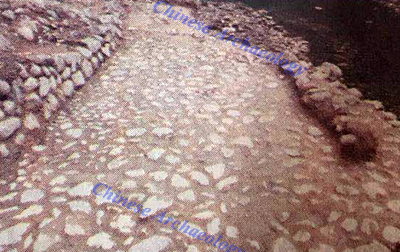An Ancient Pier ruins Unearthed in Jincun Village, Zhejiang Province
From:Chinese Archaeology NetWriter:Date:2017-10-17
From November 2016 to January 2017, the joint archaeological team of Zhejiang Provincial Institute of Cultural Relics and Archaeology and Longquan Municipal heritage protection management has conducted an initiative archaeological excavation on the site of Jincun pier. The main purpose of this archaeological excavation, which covered an area of 500 square meters, was to reveal the ruins of the pier and obtain information on its construction, age, scope, layout and other aspects. The Jincun pier site is located in Jincun Village, Xiaomei Town, Longquan City, Zhejiang Province.
Distant view of the ancient pier ruin
The remain of a large-scale pier
The remains of the pier are divided into five levels, increasing in height from south to north. The first level is about 48.5 meters in length, 1.6 to 4.3 meters in depth, and 0.45 meters thick. Its distribution is similar to a rectangle, with a slight missing part in the middle. Its outer edge is surrounded with large pebbles, while the interior is covered with flat small pieces of pebbles of various sizes. The second level is about 31 meters in length, 1.1 to 8.6 meters in depth, and about 1.2 meters thick. Its core structure is made of stones of various sizes. The third level is about 32 meters in length, 0 to 1.4 meters in depth, and about 0.75 to 1.7 meters thick. Its core structure is made of soil surrounded by stones and formed by stacked stones; large boulders are arranged mostly in the north and south direction; besides serious damage in some parts, its preservation is overall quite good. The fourth level is about 20 meters in length, 0 to 1.7 meters in depth, and about 0.2 to 0.4 meters thick. Its core structure is made of soil surrounded by stones, its eastern end is integrated with the third level, and some pebbles are found in the middle part. The fifth level is about 24 meters in length and about 0 to 0.45 meters thick. Its core structure is made of soil surrounded by stones; its eastern end is similar to that of the fourth level and integrated with the third level. To the north of the fifth level, experts suspect there is a wharf working surface and other remains; due to limitations of terrain and residential house occupation, further excavation was not allowed. On the third, fourth and fifth levels of the pier, remains of a step road were discovered.

Aerial photo of the pier ruin
In order to protect the integrity of the pier, no further excavation of its structure were undertaken. At present, we can only make a general judgment based on the relics as to the era of construction and expansion of the pier, which should be between the Northern Song Dynasty and the Republic of China era. In addition, during the excavation process, to the south of the second level of the pier, near the river bank, ruins of a stone building were found. In view of its stratigraphic relation with the pier, it may be a river embankment constructed using the original pier remains by modern coastal residents.

Unearthed specimen
A great number of porcelain specimens were unearthed
Archaeological excavations unearthed a large number of porcelain specimens, mostly Longquan kiln celadon and a small number of blue and white fragments. The times span of Longquan kiln celadon is larger, spanning from the middle Northern Song Dynasty to the Ming Dynasty; its objects consist mostly of open mouth bowls, beam-mouth bowls, flat-bottom plates, eight-trigram furnaces, stem cups, etc., and a number of individual artifacts are engraved. Blue and white porcelain are mainly produced in the Jincun kiln during the Republic of China era; main types of objects are bowls and plates, among others.

The photo showed the ruin's detail
For the first time, the excavation revealed a large-scale pier ruins. It provided detailed information to restore the structure and layout of the ruins of Jincun Pier, and a detailed material basis for the park construction as well as the exhibition and protection for application as the list of world heritage. (Translator: François Dubé)

